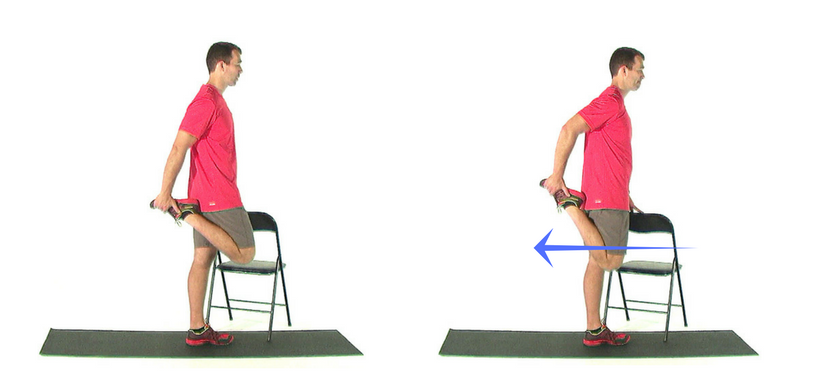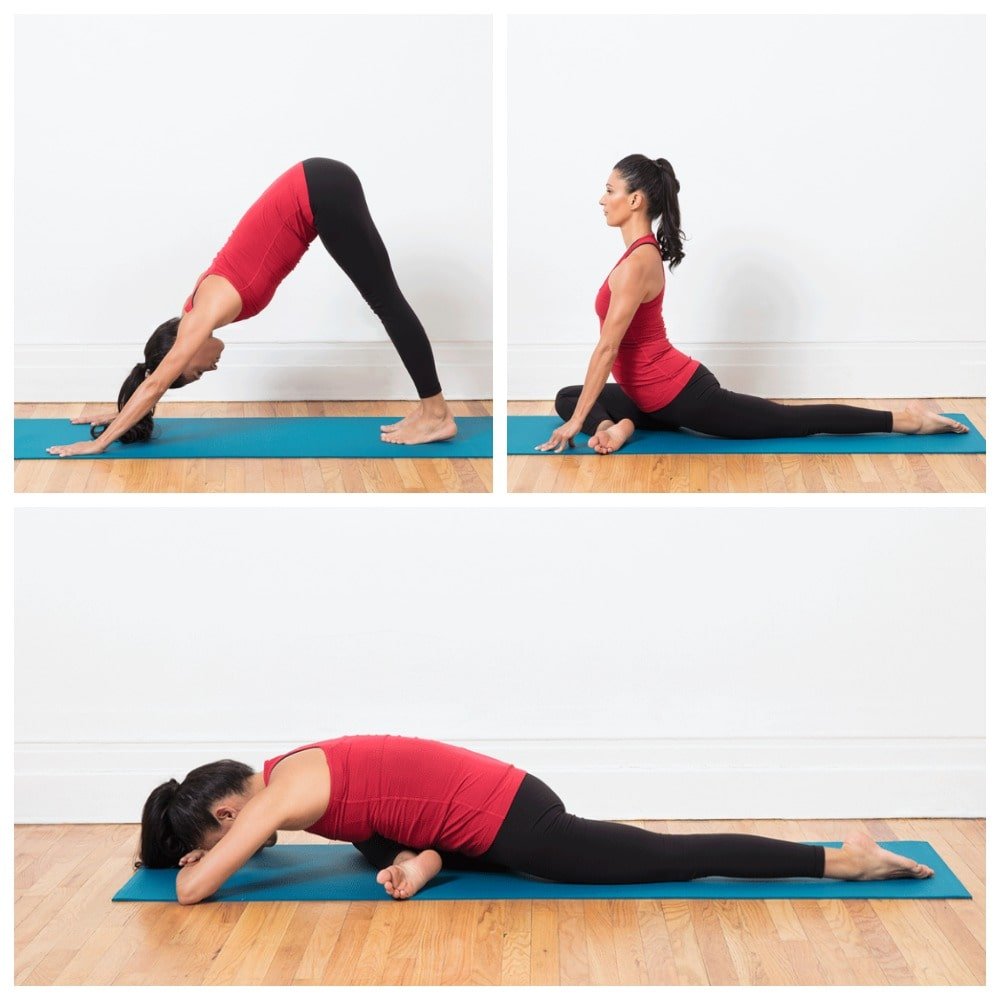Table of Contents
Stretching your quad muscles is a great way to improve flexibility and prevent injuries. Stretches for Quad Muscles are crucial for many movements, from walking to jumping, and keeping them flexible can enhance your overall performance. Here, we present the top 10 stretches to help you keep your quad muscles in top shape.
Key Takeaways
Lying Quad Stretch


The lying quad stretch is a fantastic way to target your quadriceps, especially if you prefer to stretch while lying down. This stretch is particularly beneficial for those who experience knee pain or prefer a more relaxed position.
Steps to Perform the Lying Quad Stretch
- 1. Lie face down on a comfortable surface, like a mat.
- 2. Prop your head up with your left hand for support.
- 3. Bend your right knee and reach back with your right hand to grab your ankle.
- 4. Gently pull your ankle towards your buttocks until you feel a stretch in your quad.
- 5. Hold this position for 30 seconds.
- 6. Release and switch sides, repeating the stretch with your left leg.
Tip: If you find it difficult to reach your ankle, you can use a strap or belt to help pull your foot closer.
Regularly stretching your quads can help increase flexibility and range of motion, which may alleviate knee pain and improve your posture. This stretch is also great for muscle recovery after a workout.
Remember, the benefits of stretching your quads include increased flexibility, better range of motion, and potential relief from knee pain. Make sure to incorporate this stretch into your routine to keep your muscles healthy and flexible.
Simple Quad Stretch


The Simple Quad Stretch is a great exercise to fix your muscles anytime, anywhere. It’s easy to do and very effective.
- 1. Stand on your left leg, keeping one knee touching the other. If needed, hold onto a chair or wall for balance.
- 2. Grab your right foot with your right hand and pull it towards your butt. Push your chest up and hips forward.
- 3. Focus on feeling the stretch in your quad muscle and pushing your hips forward to get a good hip flexor stretch.
- 4. Hold the position for 20 to 30 seconds.
- 5. Switch legs and repeat the stretch on your left leg.
If you are a desk worker, stop and do this stretch every couple of hours. It can help relieve tight muscles and improve flexibility.
Kneeling Quad Stretch


The kneeling quad stretch is a more advanced stretch that uses your body weight to stretch the quad muscle while keeping the hips and pelvis neutral. This stretch is great for improving flexibility and preventing knee pain.
Steps to Perform the Kneeling Quad Stretch
- 1. Kneel on your left knee.
- 2. Place your right foot 12 inches in front of you with the knee bent at a 90-degree angle.
- 3. Tighten your stomach and pelvic muscles.
- 4. Lean forward with your upper body straight, feeling the stretch in your quad.
- 5. Hold for 30 seconds.
- 6. Release and repeat on the opposite side.
This stretch not only targets the quads but also helps in stretching the hamstring muscles, making it a comprehensive lower body stretch.
Remember to move slowly when changing legs to avoid muscle strains. This stretch is particularly beneficial for those who sit for long periods, as it helps in loosening the muscles just above the knee joint, increasing mobility and preventing knee pain.
Lying Pigeon Progression


The Lying Pigeon Progression is a fantastic way to stretch your quads and maximize your flexibility with lower body stretches. This pose also targets your back and hip flexors, making it a comprehensive stretch.
- 1. Place a mat on the floor and lie face down.
- 2. Secure a resistance band around your left foot, with the excess band in a reachable area. If you don’t have a resistance band handy, you can use a towel instead.
- 3. Grab the band with your left hand. While keeping your right leg extended, bend your left knee, keeping your toes pointed toward the ceiling.
- 4. Use the resistance band to pull forward until you feel the stretch. Hold for twenty seconds then pull further.
- 5. Return to starting position and repeat on the other side.
This stretch is not only great for your quads but also helps you progress to more advanced poses like the pigeon and pigeon twist stretches.
Frog Pose


The Frog Pose is a fantastic stretch for your quads, glutes, and inner thighs. It’s especially useful for those who need a quick and effective stretch after an intense workout. This pose also helps in stretching your arms, chest, and shoulder blades.
How to Perform the Frog Pose
- 1. Start on all fours with your knees wide apart.
- 2. Flex your feet to turn your toes outwards.
- 3. Slowly move your knees out to the sides as far as comfortable.
- 4. Lower your forearms to the ground and keep your back flat.
- 5. Hold this position for about 30 seconds, then gently release.
This pose is great for a cool-down routine and helps improve overall fitness by enhancing flexibility in multiple muscle groups.
Lying Side Quad Stretch


The lying side quad stretch is a great option for those who find it hard to balance on one leg. This stretch is perfect for people with hip, knee, or ankle issues. It’s also suitable for older adults or those with obesity.
Steps to Perform the Lying Side Quad Stretch
- 1. Lie down on your left side on a soft surface like a yoga mat.
- 2. Bend your right knee and reach back with your right hand to grab your foot.
- 3. Pull your foot towards your buttocks as much as you can.
- 4. Hold this position for 30 seconds.
- 5. Release and switch to the other side.
If you find yourself falling forward, try extending your lower leg to help maintain balance.
This stretch is not as convenient as the easy quad stretch because you need a mat or something soft to lie on. However, it’s a very effective way to stretch your quads without putting too much strain on your joints.
Prone Quad Stretch


The prone quad stretch is a great way to target your quad muscles without putting too much strain on your body. This stretch is especially useful for those with limited flexibility or balance issues.
How to Perform the Prone Quad Stretch
- 1. Lie flat on your stomach on the floor.
- 2. Extend your left arm forward for balance.
- 3. Bend your right knee.
- 4. Reach back with your right hand and grab your foot.
- 5. Pull your foot as close to your buttocks as possible.
- 6. If you can’t reach your foot, try looping a belt or strap around your foot and pulling on that.
- 7. Hold for 30 seconds.
- 8. Release and repeat on the opposite foot.
This stretch is often recommended in physical therapy and sports medicine for its effectiveness in improving flexibility and aiding in rehabilitation.
Incorporating the prone quad stretch into your warm-up routine can help with injury prevention and enhance your athletic training. It’s also beneficial for those involved in strength training as it helps to keep the muscles flexible and ready for action.
Camel Pose


The Camel Pose is a classic yoga posture that stretches the quad muscles against gravity. This pose not only enhances flexibility but also improves overall wellness by opening up the chest and shoulders.
How to Perform the Camel Pose
- 1. Kneel on the ground with your knees hip-width apart and your upper body straight.
- 2. Place your hands on your lower spine.
- 3. Lift your chin toward the ceiling and tilt your upper body back while pushing your hips forward.
- 4. Reach back with both hands and grab your heels.
- 5. Open your chest and pull your shoulder blades together.
- 6. Hold the position for as long as you comfortably can.
- 7. Release your hands, pull the pelvis back, and bring your upper body back to a neutral position.
When performing this exercise, keep your torso upright and your spine aligned. Then squeeze your left gluteal (buttocks) muscle. Press your left hip forward until you feel a stretch in the quad muscles.
This pose is excellent for improving posture and can help alleviate tight quad muscles, which often relate to low back pain. Incorporating the Camel Pose into your routine can significantly enhance your flexibility and overall wellness.
Pigeon Pose


The pigeon pose is a classic hip opener that may offer relief to tight hips, lower back pain, and achy piriformis and psoas muscles. This pose is highly effective for improving leg mobility and flexibility. It targets the glutes and upper leg muscles, which can become compressed and tense from prolonged sitting.
How to Perform Pigeon Pose
- 1. Start in a downward-facing dog position.
- 2. Move your right knee between your hands to get into a pigeon pose.
- 3. Place your right hand beside your right cheek and bend your left knee.
- 4. Reach for your left foot with your left hand, gently guiding its sole towards your left hip.
- 5. Position your left hand on top of your left foot and slightly rotate towards the left, wrapping your right hand around your back.
- 6. Use your hands to press into your body, deepening the twist. Maintain this position for approximately five breaths before releasing your hands and extending your left leg.
Incorporating pigeon pose into your routine can help alleviate discomfort and improve flexibility.
This pose is often included in Pilates routines due to its effectiveness in stretching and strengthening the muscles.
Conclusion Top 10 Stretches for Quad Muscles
Stretching your quad muscles is essential for maintaining flexibility and preventing injuries. By incorporating these top 10 stretches into your routine, you can improve your range of motion, reduce muscle soreness, and enhance overall leg strength. Remember, consistency is key. Make stretching a regular part of your fitness regimen, and you’ll notice significant improvements in your flexibility and comfort. Whether you’re an athlete or just someone looking to stay active, these stretches will help keep your quads in top shape. So, take a few minutes each day to stretch, and your body will thank you!
Frequently Asked Questions
How often should I stretch my quads?
It’s a good idea to stretch your quads at least 2-3 times a week. If you are very active or experience tightness, you might want to stretch them daily.
Can I stretch my quads if I have knee pain?
Yes, stretching your quads can actually help reduce knee pain by loosening tight muscles that may be pulling on your knee joint. Just be sure to stretch gently and stop if you feel any sharp pain.
How long should I hold a quad stretch?
Hold each quad stretch for about 20-30 seconds. Make sure to breathe deeply and relax into the stretch to get the best results.
Do I need any special equipment to stretch my quads?
Most quad stretches don’t require any special equipment. However, a yoga mat can make floor stretches more comfortable, and a resistance band or towel can help if you have trouble reaching your foot.
Can stretching my quads improve my flexibility?
Yes, regularly stretching your quads can improve your overall flexibility, making it easier to move and reducing the risk of injury.
Is it better to stretch before or after a workout?
It’s generally better to stretch after a workout when your muscles are warm. However, you can do a light stretch before exercising as part of your warm-up routine.














Leave a Review